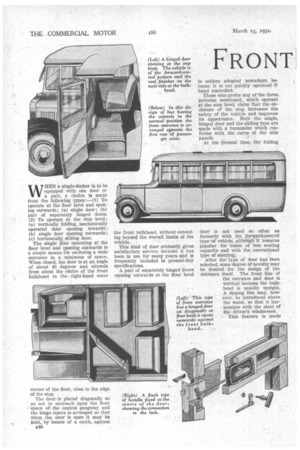FRONT ENTRANCES
Page 66

Page 67

If you've noticed an error in this article please click here to report it so we can fix it.
designing for appearance and utility
Our Bodybuilding Expert Outlines the Types of Door Already in Use and Offers Some Practical Suggestions for Improvement
WHEN a single-decker is to be equipped with one door or a pair, a choice is made from the following types;—(1) To operate at the floor level and opening outwards; (a) single door; (b) pair of separately hinged doors. (2) To operate at the step level;
(a) vertically folding, mechanically operated door opening inwards ; (b) single door opening outwards; (c) horizontally sliding door.
The single door operating at the floor level and opening outwards is a simple means for enclosing a wide entrance in a minimum of space. When closed, the door is at an angle of about 45 degrees and extends from about the centre of the front bulkhead to the right-hand outer the front bulkhead, without extending beyond the overall limits of the vehicle.
This kind of door evidently gives satisfactory service, because it has been in use for many years and is frequently included in present-day specifications.
A pair of separately hinged doors opening outwards at the floor level is seldom adopted nowadays, because it is not quickly operated if hand controlled.
Those who prefer any of the three patterns mentioned, which operate at the step level, claim that the enclosure of the step increases the safety of the vehicle and improves its appearance. Both the single, hinged door and the sliding type are made with a turnunder which conforms with the curve a the side panels.
At the present time, the folding
door is not used so often as formerly with the forward-control type of vehicle, although it remains popular for buses of less seating. capacity, and with the conventional type of steering.
After the type of door has been selected, some degree of novelty may be desired for the design of the entrance itself. The front line of the entrance and door is vertical because the bulkhead is usually upright. A sloping line may, however, be introduced above the waist, so that it harmonizes with the slant of the driver's windscreen.
This feature is made more prominent if the roof be cut back so as not to extend over the bonnet on the near side. A sloping line to the door and extending for its full length is possible if the door be set back from the bulkhead.
Another method of imparting a distinctive appearance to the front entrance is to enlarge the near-side bulkhead pillar with a boldly curved outline. As space is limited, the lower part of the curve, if swept forward, extends on to the lower part of the front wing.
Fanciful Design.
An elaborately shaped pillar is too larg,e, to make out of a solid piece of timber, therefore it is designed as a panelled framework. Instead of panelling the pillar above the waist, a fixed window is sometimes in
serted, so that further novelty is achieved and the view ahead is not unduly obstructed, The flush-type handle was invented in order that it should not add to the width of a body already built closely to the overall limit, and it is used for both the main saloon and the driver's cabin. But being a flush fitting and, therefore, in consonance with modern design, it is also employed for narrower bodies.
In view of the experience gained, in the private-bodywork business of handles providing distant control of the lock, it is not surprising to find that the flush-type handle is mounted in any position between the door pillars.
A bus or coach door seldom has a full-drop window, but even if such be required it need not prevent the handle from being arranged in any desired position, so that either the inside handle isimore conveniently placed, or it is farther away from an adjacent seat.
Not many double-deckers have so far been made with front entrances, but it is considered that it is a type of vehicle which is capable of much development. If a door be required, the front entrance is more suitable than the usual rear one.
As the entrance is wider than that of a single-decker, a sliding door or a pair of these moving in opposite directions is better than a hinged door.
A folding door at the step level takes up valuable room.
Separate Emergency Exit.
The front entrance allows the back of the double-decker to be fully enclosed, although a separate emergency exit is necessary for the lower saloon.
Whether the front entrance has a door or is a permanently open one, it may be designed in conjunction With any type of staircase that has already been adopted at the rear.




































































































